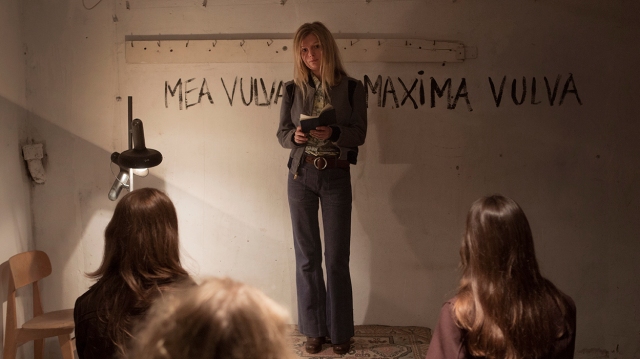There are still certain things that cannot be said, should not be said. (And a blogpost on Nymphomanic might be one of those things…) As a beginning writer, I am experiencing the addictive flow of thoughts translated unto paper, but also the paradox of the author-reader relationship. I read as I write which may be read. The purpose and reasoning behind writing is still hard to fathom.
And then there is moving images. Involving the eye, the ear. The maker, the writer, the actor, the audience, and not to forget the media who will comment on it all. An intricate relationship. But let us not linger on the question as to why it fascinates so, why it is the modern type of mesmerism.
Lars von Trier wrote and directed one of my favourite films of all time, Dogville (2003) which influenced my view on theatre immensely. And with Nymphomaniac he has outdone himself once more. Two films which are really one and the same – no annoying recaptures at the beginning of part 2, no repetition, just a clear cut halfway through: to breathe, to reflect, to muse before reaching the end. So to all those people who say part I is better than part II, I can only say: really? Are you stupid?
[Spoiler alert!]
Nymphomaniac is the tale of a woman. Not of womanhood, not of the history of women, not of the result of feminism, not of the present reality of everything. It is however a very good tale, one that reflects many general issues and at least with me was personally very moving and easy to relate to. (And yes, now I hear you think: but this was a film with excessive sex-scenes and mostly single older men go and watch it? Yes, this is true. But among the audience also a lot of young people can be found, young women, like me.)
I will not analyse all of it. It’s four hours of film. But I will try to share a few of my observations. First of all, the beauty. Although the lead character Charlotte Gainsbourg (Joe) is one of my favourite actresses, she and the many many people she meets and interacts with, many of whom probably beautiful people on themselves, none of them, none of them were beautiful. It was the visual that had a beauty, continuously throughout the film. The surrounding was perfectly beautiful. Take the opening shots, slowly following the outlines of bricks, wood, metal plates, an inner courtyard – with beautiful albeit unrealistic sounds as if one is feeling the images resonate. And then there is the fascination with trees, the myths surrounding the relationships of the trees, the one more beautiful than the other and mocked for it.
Another telling aspect of Nymphomaniac is the guilt. Having sex outside of conventional relationships is something to be looked down upon, at least this is what Joe says that should be done. There is no other way than to blame her for her own downfall. But throughout her story, her life, she professes no guilt at all. She explores her sexuality, her needs, her longings, and the world and all it has to offer. Especially the scene in which the betrayed wife and her children barge in on Joe and the husband is telling. It is painful, not because of the betrayal. But because Joe has no remorse – and should we? It is painful because of the reaction of the wife, the symbol of tradition. The way Von Trier captured this moment makes the audience side with Joe, but not because all of a sudden we think adultery is a good thing. It is an existentialist pragmatism that we relate to. Which is why this film should not be seen as general ideological piece of film, but as a specific story. (Independent of the fact of how many women face the same challenges as Joe.)
One of the most interesting parts is the manner in which her life is analysed. The metaphors of fishing, the stain on the wall. But the theory of the three types of lovers – the patient one (the man in the red car, waiting patiently for his turn, taking his time and only involved with the other), the tiger (taking control, knowing himself and mastering the other) and the lover (the unfathomable, the one which makes feeling key, until it becomes impossible) – might be the most interesting one.
And finally, the end. (I mentioned spoilers, right?) Joe shooting down the man who had listened carefully to her story, but then trying to take advantage – because she had been with so many men, what could she possibly have against it? This act, this saying ‘no’ – for the first time in her life – is maybe the whole point of the film. Something that could be said to be true of today’s position of women. (Or maybe of Simone de Beauvoir’s world.) Women are to excel both at home and in a career, taking every opportunity to impress, being feminine while facing a world in which the feminine is still regarded a weakness when it comes to business and success. Joe takes her own sexuality as more important than the one of the other (mea vulva maxima vulva), in a way her response to her frustration, the opportunities provided, her turning her knowledge of a man’s sexual preferences into a criminal enterprise is neither male nor female. She is searching for her place, as a person – outside of that encompassing dichotomy. And it is the ‘no’, the shot that ends the film, that breaks this search. It is the end.

2 reacties op “On Lars Von Triers’ Nymphomaniac”
Heel mooi beschreven. Doet recht aan de film en ook mijn beleving.
wil graag je posts ontvangen